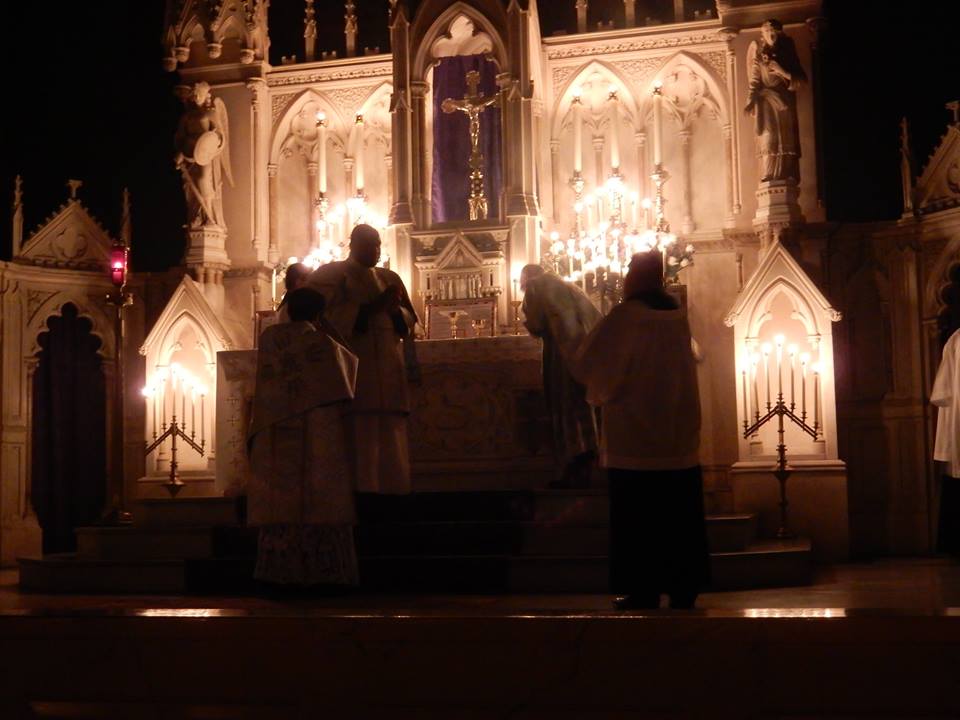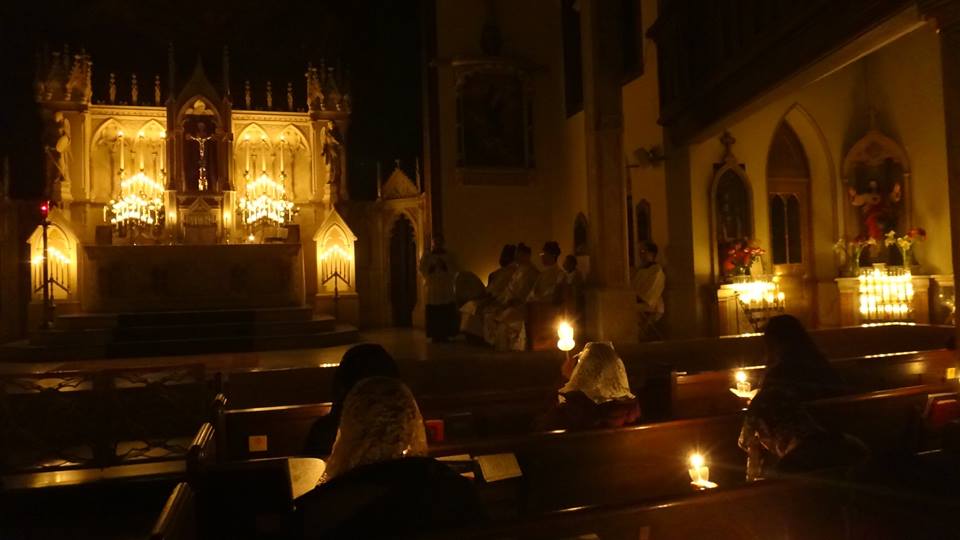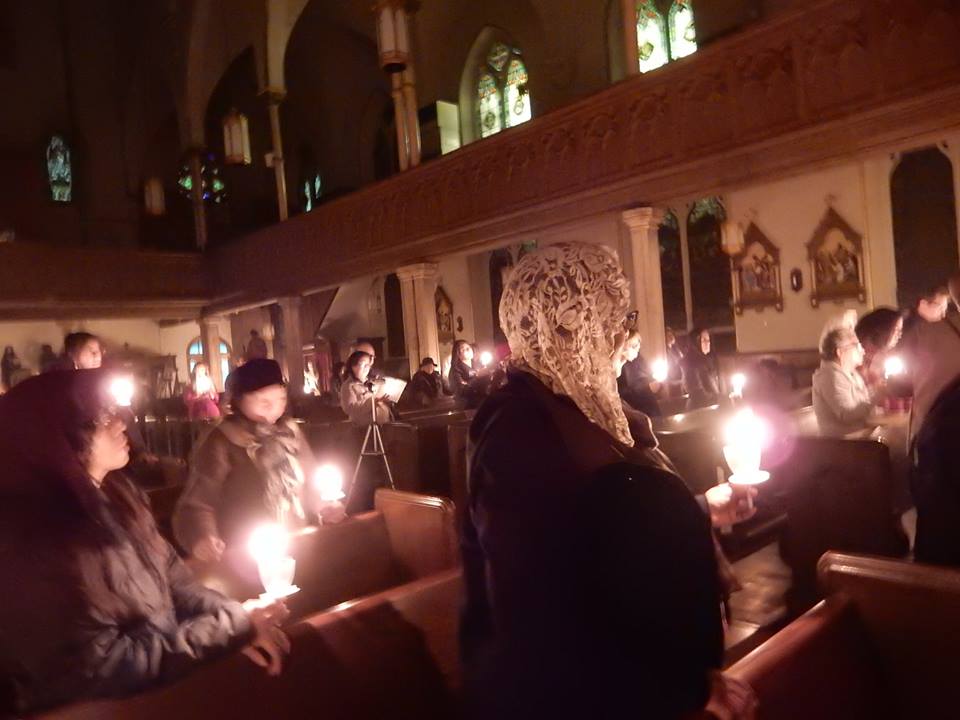Some of you have written asking about “Rorate Masses” during Advent.
This is a beautiful custom whereby Mass is celebrated illuminated only by candlelight. They are usually before dawn.
The Mass is a Votive Mass of the Blessed Virgin, and so it is celebrated in white, rather than Advent purple. “Rorate” is the first word of the Introit chant for a Votive Mass of the Blessed Virgin in Advent. There is also a beautiful Advent Gregorian chant hymn that uses this text, which comes from Isaiah 14.
One way that I have heard this done is that, while the hymn Rorate caeli begins, the priest and people, who have gathered outside, process into the church. At the end of the hymn, prayers at the foot of the altar begin as the chant Rorate is sung if it is a Missa Cantata. When the Gloria is sung (for the Blessed Virgin’s votive Mass) the lights of the church are turned on. That’s one way. Otherwise, the lights remain off, as they would have, obvious, in time before electrification.
It could be good to time to end of Mass as the sun is rising.
Are you having Rorate Masses where you are?
A friend sent me photos of the Rorate Mass recently celebrated at the vibrant parish of Holy Innocents in Manhattan. Here are a few snaps.





































I don’t know if it qualifies as a Rorate Mass, but at my TLM church, we usually sing the “Rorate” as the very last part of Mass (instead of the usual Marian antiphon) during Advent. Otherwise, vestments are the usual Advent purple….
I forgot to mention that the Mass is a usual Advent Sunday Mass (1st class), so definitely not a votive mass… but the Rorate is sung nevertheless…
Aren’t these technically (and accidentally) disallowed under the 1961 rubrics? Hagan Lio, if so.
Rellis, I’m just speculating, but I would assume that Rorate Masses are treated as III class votive Masses, even though they are not specifically mentioned in John XXIII’s Code of Rubrics, as every Rorate Mass I have heard of has fallen on a day of the III class, whether a III class feast or a feria of Advent. If anyone has any specific documentation that would confirm or correct this assumption, I would be most welcome to it.
While not technically a “Rorate” Mass in the OF I have customarily celebrated the Morning Mass of December 24 with minimal electric lighting (a bit of mutual enrichment)
Old St. Mary’s, Cincinnati, celebrated the traditional Rorate Mass again on 12/5.
Extraordinarily beautiful (no pun intended) with a magnificent choir, and the oratory-in-formation insuring that it was a fitting celebration to honor Our Lady.
Lots of young people in attendance from Cincinnati and Dayton.
https://www.facebook.com/events/1685958448293814/
Started at 6:45, timed so that the sun was just starting to rise at the time of consecration.
Thank you, Fr. Bevak! (pastor of O.S.M.)
Filipinos continued the practice of the Rorate Mass in the Ordinary Form and is known as the Simbang Gabi or the Missa de Gallo. In the Ordinary Form, it is a Votive Mass to the Blessed Virgin Mary during Advent, and by indult, Filipinos celebrate this Mass as a novena to Christmas starting December 16th. They wear white vestments, traditionally sing Marian hymns, and as it is treated as a vigil to Christmas, Christmas songs may be sung as well.
The reason why there are two names when the Filipinos do it is because the Missa de Gallo, or Rooster Mass, is the old traditional Mass, held at 5 am, and is called such because at the end of the Mass, the roosters crow.
During the reign of Ferdinand Marcos, a curfew was issued which essentially banned the Missa de Gallo, and so Filipinos requested an indult that allowed them to celebrate this Mass in the evening, which is where we get the term Simbang Gabi, or Evening Mass.
In my diocese here in New Jersey, the Filipinos have arranged for the celebration of this novena throughout the diocese. We have one designated church to celebrate the Missa de Gallo for the entirety of the novena, meaning 5 am Mass every day, from 16-25 December. Then we have designated churches throughout the diocese to host the Simbang Gabi, typically at 7 pm.
This year, I’m in charge of the music at my church for the Simbang Gabi because people my age absolutely despised the charismatic choir doing the music at the Mass. They had a drum set, electric guitars, and it just did not sound good. Apparently the Filipinos of the diocese are looking forward to it because they heard that I gathered my friends from college to form the choir, and Filipinos absolutely love anything where the youth is involved. What they don’t know is that while we have the Mass Ordinary prepared in Tagalog, we also have the Gregorian Chant propers prepared and Biebl’s Ave Maria. It’s gonna be, for lack of a better work, exciting.
Mater Ecclesiae in Berlin, NJ, will be having its first-ever Rorate Mass on Saturday, December 12 at 6:00 am.
FSSP Parish St. Joseph’s in Tacoma, Washington will have a Solemn Rorate Mass on December 12th at 6:30 AM.
St. Anne (FSSP) church in San Diego will have one on Saturday morning the 12th.
In Bratislava (Slovakia) we have Rorate holy masses almost daily early in the morning, in turn in different churches.
The one on the last Saturday was especially nice, NOM ad orientem, sung by a small mixed schola (lead by my wife, with me as one of singers, the average age of the schola perhaps 25), with the ordinarium and some of propria in Latin.
The priest had been a bit reluctant about Latin some days before the holy mass, but then he was very impressed by the “prayerfull atmosfere”, people thanked everyone who helped with the organization, singing, etc.
At least two bricks, I would say. :-)
The FSSP have an evening Rorate Mass twice a week, around here. Very convenient of course, not having to get up.
By the way, dear LB236, Schott says that at least in Germany “it varies depending on the circumstances and places but in general”, the Rorate Mass is a votive Mass of the second class (!). I’ll be going there today, but it will be of the solemnity, I hope… with some candles.
Novus Ordo parishes also have Rorate Masses… usually, I think, “of the day” in violet vestments. The Dominicans, though, celebrate an actual (early-morning – so you get the benefit of really doing something, getting up extra early) Rorate Mass (with folk-traditional music – very beautiful) as an actual votive mass of the Blessed Virgin, which can be seen in the golden vestments, the prayers and the Preface… though they take the reading and Gospel from the Advent day.
Schott = the most popular German lay missal, edited by the monks of St. Beuron, originally a Fr Anselm Schott OSB. Don’t know if that is known elsewhere, so I had better explain.
In Trier, Germany, Rorate Masses at 08:00 on Saturdays 12th and 19th December 2015.
Helenenhaus Kapelle – Institut St Philipp Neri
http://www.schilling-trier.homepage.t-online.de/media/20a0722725d8d315ffff801cfffffff1.pdf
My parish is having one of these and I’m hoping to drag myself out of bed this Saturday to attend. :)